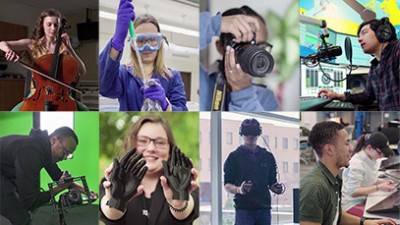RIT expands its workforce initiatives for the semiconductor industry
Pilot program calls for community college students to expand skills in preparation for transferring into RIT’s microelectronic engineering program
Gabrielle Plucknett Devito/RIT
Students area able to acquire hands-on skills in computer chip development processes in RIT’s Semiconductor Nanofabrication Laboratory.
Rochester Institute of Technology will take the lead on a new program that allows community college students to join the growing semiconductor industry. The intent is to build a pipeline of skilled employees for a strategic U.S. manufacturing industry.
Community college students from diverse backgrounds will earn associate degrees in engineering science and then transfer into RIT’s microelectronic engineering program to attain a Bachelor of Science degree through comprehensive hands-on training on the development of next-generation semiconductor technologies.
RIT received nearly $1 million from the National Science Foundation to establish Beginnings: Empowering Minds through Experiential Learning, Research, and Career Growth Opportunities in Emerging Microelectronics (EMERGE-MICRO). The program will prepare community college students to advance new materials, lead cleanroom operations, and coordinate simulation and testing processes, all essential to building computer chips for today’s electronic devices, systems, and industries.
Key partners are Monroe Community College and Finger Lakes Community College, both of which have strong programming in engineering, science, and physics. Corporate partners include Micron Corp. and GlobalFoundries, international manufacturers of computer chips.
RIT
Parsian Mohseni, associate professor in RIT’s Department of Electrical and Microelectronic Engineering, will lead the new NSF grant to expand workforce initiatives in computer chip design, development, and fabrication.
“The workforce needs of the microelectronic industry by far exceeds the supply of skilled workers that we have today,” said Parsian Mohseni, associate professor of electrical and microelectronic engineering at RIT’s Kate Gleason College of Engineering. “This is an all-hands-on-deck scenario where we need to create pathways for new talent into the field to support domestic growth in semiconductor manufacturing.”
The EMERGE-MICRO program is a pilot program or model that can be scaled nationwide to continue feeding the manufacturing industry with its needed workers.
“RIT has a long-standing history of excellence in microelectronic engineering,” Mohseni said. “We are the oldest and first university in the country to start a dedicated program in microelectronic engineering that involves not just extensive coursework but experiential learning through laboratory courses and, more importantly, research and co-op placements. Our graduates have a 100 percent work placement rate by the time they have finished their B.S. degrees.”
Extending this advantage to community college students will involve access to RIT’s Semiconductor Nanofabrication Laboratory to receive hands-on training in the extensive processes required to build today’s computer chips, specifically complementary metal-oxide-semiconductor (CMOS) devices, a key expertise of the microelectronic engineering faculty-researchers.
Community colleges will be instrumental in the recruiting process and corporate partners will help with experiential learning efforts by guiding undergraduate research directions and providing co-op work placement opportunities. They also will participate on a new advisory board for the EMERGE-MICRO project team.
The RIT award is one of several announced recently by the NSF’s Directorate for Technology, Innovation and Partnerships for its Experiential Learning for Emerging and Novel Technologies to expand workforce opportunities in high-tech areas expected to have significant economic impact in the U.S.
Impact of the program
U.S. Congressman Joseph Morelle (25th District, N.Y.) said, “One of my top priorities in Congress is to support our regional economy and help ensure our competitiveness on the national and global stages, and this new $1 million in federal funding I helped secure from the National Science Foundation will help to do just that. This funding for RIT builds on our region’s recent designation as a Regional Technology Hub and bolsters our high-skill workforce pipelines. I look forward to continuing my work with RIT to cement Rochester’s legacy as a global leader in innovation.”
Parsian Mohseni, associate professor of electrical and microelectronic engineering at RIT’s Kate Gleason College of Engineering, said, “New York State is quickly becoming a global hub for semiconductor manufacturing. RIT’s strong partnerships with Micron and GlobalFoundries ensure that our microelectronic engineering curriculum, experiential learning programs, and research activities stay up-to-date with the rapidly evolving technology landscape, allowing us to prepare our students for success and positioning us to provide the industry with its future leaders.”
Selim Araci, professor of mechanical engineering, Finger Lakes Community College, said, “Microelectronics engineering specializes in electronic chip design and manufacturing, which gained some importance with the recent federal incentives to the upstate New York area in chip manufacturing. A good example is the new Micron Technology Inc. project in Syracuse, which will need many skilled engineers and workers in microchip technology for the next decade and further. There will be excellent opportunities for students who complete this program.” Araci also serves as president of New York State Two-Year Engineering Science Association (TYESA). He will mentor and provide academic support in coordination with RIT to students selected for the program.












